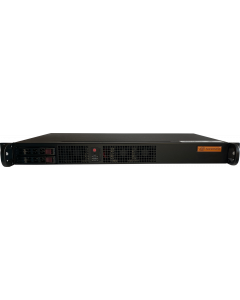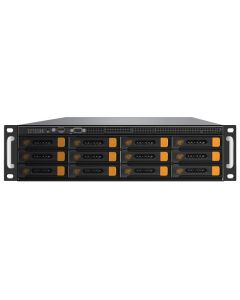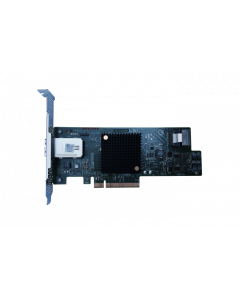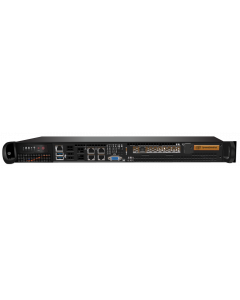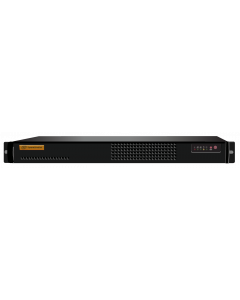

DDP is short for Dynamic Drive Pool, a shared storage solution optimized for multimedia workflows. The DDP lineup contains a series of products manufactured by Ardis, a Dutch company based in Arnhem, Netherlands.
All DDP systems include a chassis containing multiple hard drives that are accessed over a traditional Ethernet network. It is a shared storage solution that allows numerous workstations, across various operating systems, to address the files on it regardless of their size. So, whether you are working with audio or multi-layered 4K video files, this is the perfect solution to cater for a seamless workflow.
An intuitive browser-based Control Panel allows the creation of 'folder volumes' that mount as local drives on a computer's desktop. A plethora of storage and network options mean you never need to experience capacity or bandwidth issues. A DDP chassis can contain a hybrid of traditional hard drives and SSDs. SSDs can be utilised for both storage use, as well as caching.
SSD Caching
SSD caching is a common process for optimizing performance. Its most popular form is known as 'On Demand' caching. This involves copying the most frequently accessed files to SSDs, allowing work to be conducted from that location. This method means that the least used files are eventually omitted from SSD caching and pushed onto the HDDs for storage.
Although you can elect to use this method with a DDP system, Ardis has gone a step further by introducing 'Pinned Caching'. This option means you are in control of what precisely is cached and when. For example, when a very high transfer rate video such as a DPX Uncompressed sequence needs to be played, and/or when lots of rendering and transcoding processes are called upon, Pinned Caching can be selected for ultimate performance. These processes usually require lots of seek time on the regular HDDs, but because SSD drives do not require any seek time, this operation is executed flawlessly - no matter how many clients are connected or how many files need to be rendered or transcoded.
Load Balancing
The optimization of performance is key to the DDP. Sometimes it may not be enough to add drives to achieve this goal. Instead, the DDP integrates Load Balancing across its storage. For example, a 16 disk system could be configured as two separate RAID sets, instead of a single one. That way, access times between the clients and DDP are optimized. With Load Balancing, the more disks and RAID groups you add, the faster the storage.
Supported Applications:
- Avid Pro Tools
- Avid Media Composer
- Blackmagic DaVinci
- Adobe Suite
- Apple Final Cut
- Grass Valley
- Dalet
- AutoDesk
- Fairlight
- Sony
Ardis Virtual File System (AVFS)
At the heart of every DDP system is the proprietary AVFS – Ardis Virtual File System which can manage any combination of both HDDs and SSDs flawlessly.
DDP Features:
Performance
- DDP is an ethernet SAN, therefore the metadata and data can be kept separate. This means that the data can be transported at wire speed.
- Desktops have parallel access to groups disks, called Data Locations. Therefore the performance is the sum of the performance of each Data Location.
- SSD caching in the DDP eliminates the seek time effect of spindles and the performance difference between small and large files in a Hybrid DDP.
Using the flexibility of the DDP and AVFS depending on the type of storage chosen the DDP can generate a bandwidth on a Linux desktop of more then 15GB/s (with NVME storage and RDMA protocol). But even with standard DDP storage and standard iSCSI with 25, 40 or 100 GbE cards more then 2,5 GB/s per desktop performance can be obtained.
Reliability
Ardis Technologies supports the DDP products free of charge for two years against hardware and software failures. After the support can be extended for another 5 years. DDP hardware consists of standard of the shelf components, is well tested and then approved by Ardis. The company developed the DDP software in house for Image result for M&E. Any hardware or software failure is the sole responsibility of Ardis Technologies and can therefore be solved without delay.
Security
The DDP software runs on Linux Debian 10.x distribution. DDP can use HTTPS plus in addition two factor authentication for secure DDP access via web browser. For auditing the DDP collects session events such as who reads, writes, renames, erases or uses which file at which time. Such audit file can be generated and monitored instantly. When SSD and or hard disk pack(s) with encryption option are installed in the DDP, the data on these packs and Data Locations can be encrypted.
Scalability
The DDP uses a single file system with a single directory/folder structure. However files might be stored separately in different Data Locations. Because workstations access these in parallel - increasing the number of Data Locations would increase both capacity and bandwidth. Any additional DDPs or third party storage arrays holding Data Locations can be added to the configuration without any interruptions.
Modular
Building a DDP starts with one of the DDP base systems. They come with on board dual 10GbE/RJ45 ports, DDP Control Panel software and 'Archiware P5' software for data backup, synchronisation and archiving. Such base system can then be filled with HDD and SSD packs of various capacities. Network and other cards can also be added to the remaining PCIe slots.
Performance-Price Ratio
The best DDP performance is obtained using an SSD pack as a cache. On the other hand HDD spindles provide the highest capacity for the cheapest price. So essentially using a Hybrid DDP gives you the best of the both worlds.
Redundancy
Users and applications connected to a High Availability DDP solution can continue with ingesting, editing, colouring, streaming and so on when a failover occurs. A failover can occur suddenly because of a problem or it can be planned because maintenance is needed. In critical play out situations in addition to the HA solution a setup with an SSD cache and HD packs works best. For critical ingest situations in addition to the HA solution it is advised to have at least RAID 6 protection and have a spare HD Data Location.
DDP in Education
As a modular based system, the DDP offer many opportunities to intergrate with an existing network infrastructure. Options include:
•. Ethernet cards up to 200Gb/s
•. Fibre cards
Capacity and bandwidth requirements are carefully assessed while producing the appropriate DDP solution. Under consideration would be the applications used and its required resolutions.
The DDP's built-in workflow management allows administrators to create users and groups linked to specific volumes. For example, a group could be a Course name for a particular year. Permissions could then be set for the associated users to only access volumes relating to their course. Further, upon a student's login, this would automatically mount onto their desktop their associate volume. The DDP also has the ability to automatically create user names, groups and volumes (with size quotas) en masse using an optional, customized script that can be linked to an Active Directory protocol. This time-saving feature can prove invaluable at the start of term, as it can simultaneously remove extraneous users, groups and volumes.
Require a Super-Fast DDP for those demanding projects?
DDP10EF - Extremely Fast NVME Storage Solution


The DDP10EF is a high-performance shared storage solution (up to 10GB/s) designed for workstations editing 8K uncompressed video. It utilizes NVME flash memory and supports multiple protocols (NVMe-oF/RDMA, iSCSI, SMB). The base system offers scalable storage capacity (RAID 5) and bandwidth (up to 40GB/s read, 24GB/s write) with additional NVME drives. Mac Pro users can leverage iSCSI for good performance, while Windows and Linux can benefit from NVMe-oF/RDMA for maximum speed. The system comes in various pre-configured SSD capacities, ranging from 960GB to 30.72TB.
HSmicroDDP25GbE - Portable Hot-Swappable SSD Storage


HSmicroDDP25GbE, a compact shared storage solution for media professionals! This 1U server boasts hot-swappable SSDs for capacities up to 30TB and delivers blazing-fast read/write speeds of 1.2GB/s. Transfer, edit, and playout any media format with ease, thanks to broad compatibility across Windows, Mac, and Linux. The HSmicroDDP25GbE is ideal for field work with its portability, low noise operation, and diverse connectivity options including 1GbE, 10/25GbE, and USB ports.
Dual HA DDP Head - AVFS Flexible Fast Storage File System


A pre-installed Dual HA AVFS Head for easy management, scales to your storage and bandwidth needs, and integrates seamlessly with various storage arrays using FC, iSCSI, NVME-oF/RDMA, or Infiniband. Optimized for M&E with file-based caching, folder-based access rights, transparent data movement, and parallel data access, AVFS empowers collaborative editing and efficient management of large, unstructured media files.

